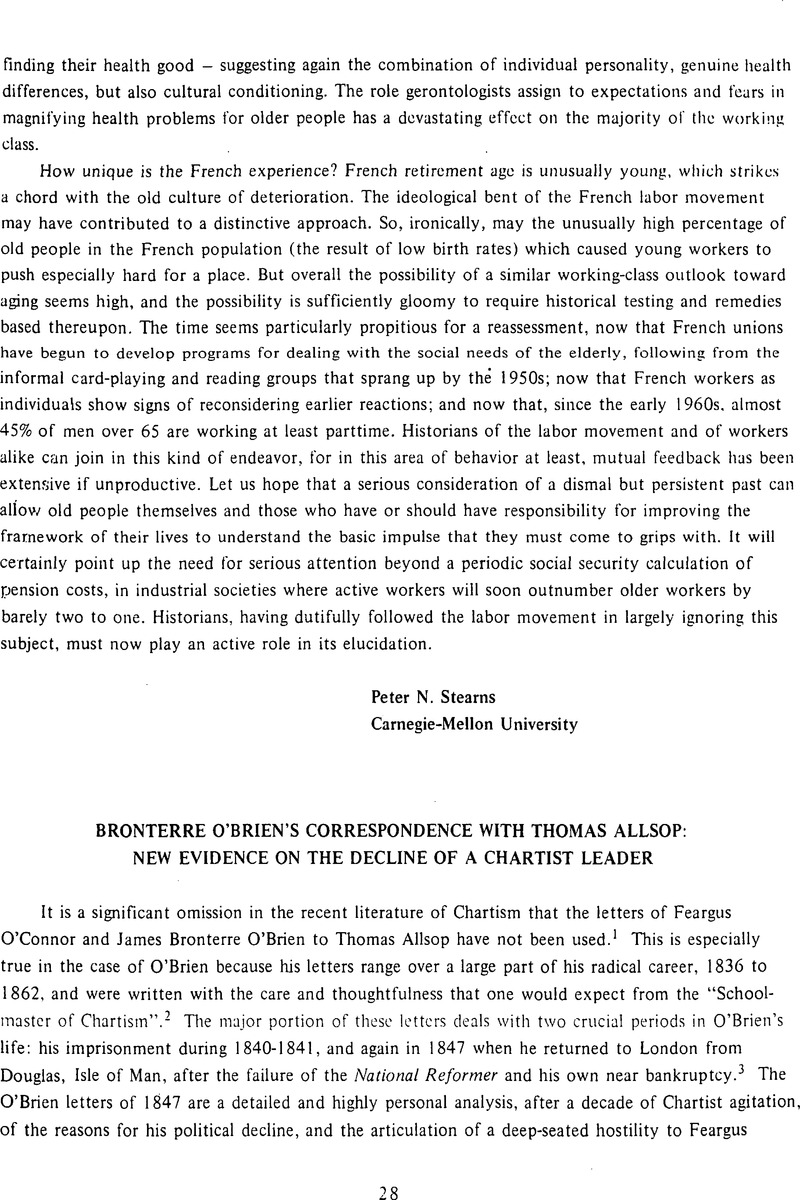Published online by Cambridge University Press: 16 December 2008

1. The Thomas Allsop Collection of Chartist Letters is deposited in the London School of Economics Library. There are twenty-three letters from James Bronterre O'Brien for the period 1836 to 1862 (seven letters cannot be precisely dated) and thirty-one letters from Feargus O'Connor, 1840–1849 (fifteen O'Connor letters are undated). The LSE library staff has numbered each set of letters but the ranking is not always chronological. Thomas Allsop (1795–1880) was a well-to-do London stockbroker with wide contacts in both literary and radical circles. He was a friend and disciple of Samuel Coleridge as well as the editor of his letters. Allsop was also a friend of other literary figures including Charles Lamb, William Hazlitt and Barry Cornwall. During the 1830's Allsop became involved with many radicals, and besides O'Brien and O'Connor, he knew William Cobbett and was a lifelong intimate of Robert Owen and G. J. Holyoake. For more de-tails on Allsop's life see Holyoake's entry in the DNB. Also of interest are the letters of Robert Owen to Allsop in the John Burns Papers, British Museum.
2. There is no surviving correspondence between the two men during O'Brien's editorship of Henry Hetherington's influential Poor Man's Guardian.
3. Three letters were written while O'Brien was in prison; twelve were written during 1847.
4. The only recent interpretive essay which deals with the Chartist elite and the problems of Chartist strategy is Kemnitz, Thomas Milton, “Approaches to the Chartist Movement: Feargus O'Connor and Chartist Strategy,” Albion. V. (1973), pp. 67–73Google Scholar.
5. The prison letters were secretly smuggled out and hence were not read by the authorities. O'Brien to Allsop, dated respectively, June 17, 1840, June 23, 1840, and August 4, 1840 (Numbers 2, 3, 4).
6. Lovett, William, Life and Struggles. (London: MacGibbon and Lee, 1967 [1876]), pp. 183–184Google Scholar.
7. O'Brien to Allsop, June 17, 1840 (#2).
8. Ibid.
9. O'Brien to Allsop, June 23, 1840 (#3).
10. O'Brien to Allsop, August 4, 1840 (#4). O'Brien made other references to suicide; see, for example, O'Brien to Allsop, August 31, 1847 (#19).
11. O'Brien to Allsop, June 23, 1840 (#3).
12. Twelve of the twenty-three letters were written by O'Brien in 1847 beginning in early April: the bulk of the correspondence was during August and September.
13. O'Connor to Allsop, undated but probably late 1847 (#12 in the O'Connor file).
14. It is apparent from the correspondence that Allsop had given O'Brien some financial help during his difficult days as a bookseller at Douglas. Allsop was also trying to help O'Brien become an agent of Abel Heywood (1810–1893), the radical Manchester bookseller and publisher. O'Brien to Allsop, November 10, 1847 and December 8, 1847 (#'s 6 and 7).
15. O'Brien to Allsop, August 7, 1847 (#15).
16. Quotation from Allsop's previous letter. O'Brien to Allsop, August 7, 1847 (#15).
17. O'Brien to Allsop, September, 1847 (#18).
18. O'Brien to Allsop, September, 1847 (#20).
19. O'Brien to Allsop, September, 1847 (#21).
20. Ibid.
21. Ibid.
22. Quotation from Allsop's previous letter. O'Brien to Allsop, September, 1847 (#22).
23. O'Brien to Allsop, September 1847 (#22).
24. For examples of the letters O'Connor wrote to Wheeler see Stevens, William, A Memoir of Thomas Martin Wheeler. (London: John Bedford Lens, 1862),Google Scholar and Faherty, Ray, “The Memoir of Thomas Martin Wheeler. Owenite and Chartist”, Bulletin of the Society for the Study of Labour History (Spring, 1975), pp. 11–13.Google Scholar For O'Connor's correspondence with Harney see , Frank and Block, Renee, The Harney Papers. (Assen: Van Gorcum and Co., 1969)Google Scholar.
25. It is clear that O'Connor and Allsop were convivial drinking companions on many, occasions.
26. O'Connor to Allsop, November 9, 1847 (#5).
27. . O'Connor to Allsop, undated but probably late 1847, early 1848 (#20).
28. O'Connor to Allsop, April 26, 1840 (#22).